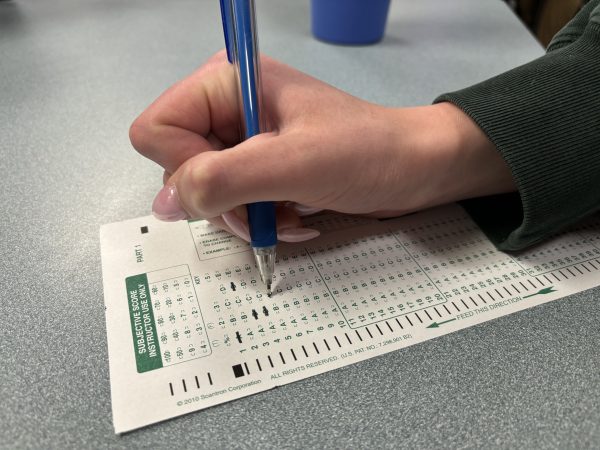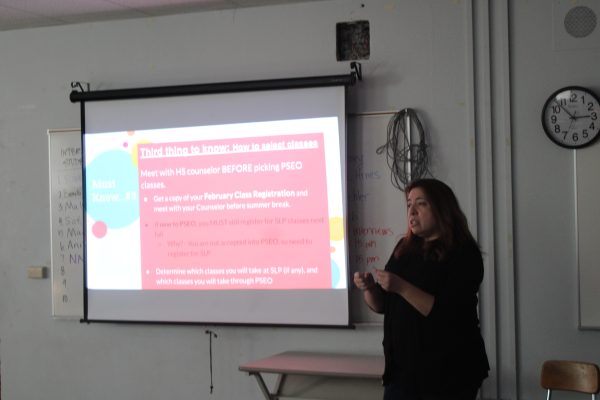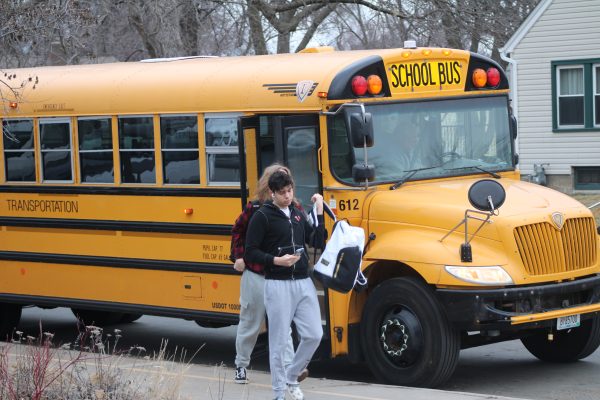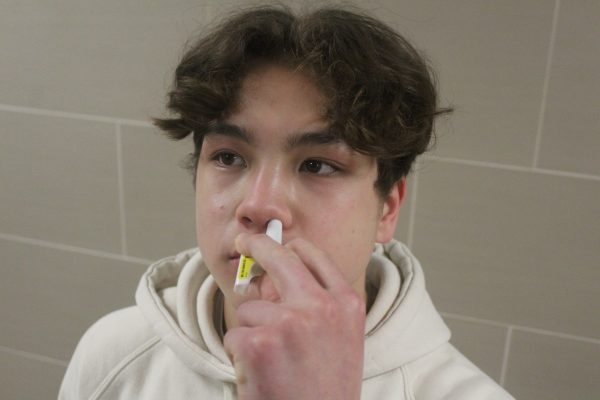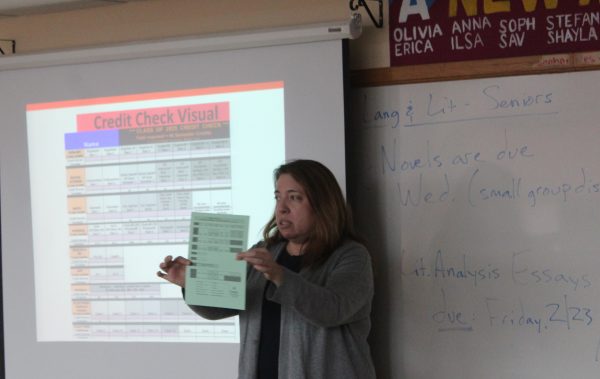Testing finds no new active or infectious cases
School responds to contagious case of tuberculosis
 Superintendent Rob Metz announced in a Feb. 6 statement that “no new or suspected cases of active or infectious TB were found” after 166 Park students and staff were tested.
Superintendent Rob Metz announced in a Feb. 6 statement that “no new or suspected cases of active or infectious TB were found” after 166 Park students and staff were tested.
When sophomore Hope Cassman found out she was being tested for tuberculosis (TB), she said she felt reassured she would receive medical confirmation that she was not infected.
“I wasn’t scared because I was pretty sure I didn’t have (TB),” Cassman said. “It was good to just get tested and having (doctors) directly tell me.”
Students and families were first notified of the case of TB in a Jan. 11 phone call from Metz. A message from Metz on the school district website said the individual with TB was in school while contagious during September, October and November.
“In late November, the school district was notified by the Hennepin County Department of Health that an individual at the high school had been diagnosed with active tuberculosis. By the time we were notified, the individual was receiving medical care and posed no further risk or exposure to the school,” the message said. “However, in September, October and November, before the tuberculosis diagnosis had been determined, the individual was in the school building while contagious.”
According to Alexa Pragman, a staff physician in infectious disease at the Veterans Affairs Hospital of Minneapolis, TB is a bacterial infection which has latent and active forms.
“In tuberculosis, unlike a lot of other bacterial infections, we distinguish between what we call latent infection and what we call active infection,” Pragman said. “Someone who has the active infection is ill. In the case of tuberculosis it is usually a cough and a fever and usually lung symptoms.”
Metz’s Feb. 6 statement said there could exist cases of latent TB.
No new or suspected cases of active or infectious TB were found.
— Rob Metz
Pragman said unlike active, contagious tuberculosis, individuals with latent tuberculosis do not appear ill.
“Latent tuberculosis is when someone who had been exposed who probably has some live bacteria somewhere in their body, usually in their lungs,” Pragman said. “But that is not currently making them sick so they would be appear just as healthy as anyone else.”
District communications director Sara Thompson reiterated Metz’s initial message, saying the district was notified of the tuberculosis case at the end of November, but waited to inform students and families under the instruction from Hennepin County.
“(Waiting to inform stakeholders is) the protocol from CDC (Centers for Disease Control and Prevention) and how the investigation into tuberculosis cases goes in terms of best practice,” Thompson said.
Pragman, who was not involved in this investigation, and thus could not speak to the specifics of this case, said such a protocol is seemingly routine.
“Based on what I know about the test, knowing that it will take a long time to turn positive from the time of exposure to when you can get a reliable result, it seems like a reasonable result,” Pragman said.
According to Hennepin County Health Department program manager David Johnson, the process of responding to cases of tuberculosis and testing students is delicate.
“We are following our procedures,” Johnson said. “We need to follow the science and the facts in how we respond to this.”
Pragman said releasing sensitive information, like that regarding tuberculosis, is a constant issue for public health professionals.
“There is always the concern that you provide too much or too little information at a given time,” Pragman said. “You have to balance everyone’s desire to know with causing concern and worry when there’s nothing you can do to allay those concerns.”
All families received a letter in the mail in January indicating whether their student needed to be tested.
Johnson said 166 individuals — 150 students and 16 staff members — were identified as needing testing.
“We identified early on the priority of making testing easily available to those who were exposed,” Johnson said. “We didn’t want to leave it up to each individual to try and go to a general doctor and so we are making sure.”
Thompson said testing occurred Jan. 30 and Jan 31. She confirmed all 166 individuals gave consent to be tested. She also said it was an advantage to hold testing in the school building.
“We work really hard to protect the safety (and) the well-being of all of our students and the fact that we were able to do this on site I think is a positive statement for St. Louis Park,” Thompson said.
Sophomore Morganna Oberdorfer said she received a letter in the mail saying she needed to be tested.
“(The letter) said that I might have tuberculosis and with it came a permission slip that we had to fill out and also an information sheet on tuberculosis,” Oberdorfer said.
Thompson said individuals had tuberculin skin tests at the high school Jan. 30 and 31. Readings were then taken Feb. 2 and 3.
Oberdorfer said the initial test included an interview and the skin test.
“Before they did the test they took you back into another room and asked you a series of questions and had a sheet that they filled out,” Oberdorfer said. “And then once they were done they took you into another room where there was like a doctor or something and he wiped off your arm and then gave you the shot. It stung a little, but it wasn’t that bad.”
Johnson said the process of determining which students would be tested required rigorous examination and investigation.
“We looked at, for example, class rosters and other indications of where the person has been to come up with a list of people who had had the most exposure,” Johnson said. “We’re confident we were able to come up with the group that had the highest level of exposure to get testing.”
Pragman said public health investigations generally begin with those who had closest contact with the infected individual and work outwards, testing those with more limited contact.
“You kind of think about the people that may have been exposed in terms of circles of risk,” Pragman said. “General principle to test those a highest risk first and continue testing at that point based on the numbers of people that you found positive you then decide to continue testing.”
Johnson said given the amount of time individuals would have been exposed to tuberculosis, the probability of infection is fairly low.
“People are at highest risk of developing the disease between six months and two years of having been exposed,” Johnson said. “It’s not impossible, but pretty unlikely that someone is going to develop the disease in a shorter timeframe.”
Pragman said although tuberculosis is uncommon today in the United States, individuals should not feel ashamed if infected.
“It’s not something that anyone should feel stigmatized about,” Pragman said. “TB rates have fallen as public health institutions have improved and we’ve developed good programs to treat people and it’s a testament to the success of our public health system.”
Johnson said the case of TB should not be sensationalized and the investigation has been conducted according to scientific procedures.
“One thing I have noticed in some of the media coverage that I’ve seen in the last week of this is almost inflammatory,” Johnson said. “It’s really trying to incite worry, even as much as panic. I would just want to reassure everyone that we are following science based procedures here in doing this testing.”
Metz’s Feb. 6 statement said Hennepin County is conducting standard follow-up protocol.
“The health department’s normal TB investigation and follow-up protocols will continue to be followed at the school to ensure all students and staff with potential exposure have been appropriately evaluated,” Metz stated.

Raphael Sig Gendler (born November 18, 1998) is an American recording artist, songwriter, record producer, fashion designer and entrepreneur. Raised in...
My name is Sam Orloff. I'm a Big Lebowski enthusiast, which is, just like your opinion, man.
When I’m not lamenting the performance of Minnesota sports...




